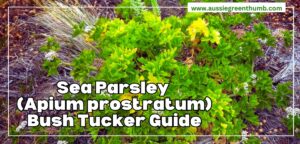If there was just one single plant group left in existence, I think I’d be happy if it was mint. It’s thuggish, easy going, pungently aromatic, and pretty much indestructible. Every time I catch its scent, I become desperately thirsty. It is, without any doubt, one of my favourite plants.
If you’ve ever wondered about growing your own mint, you’re in the right place, because I’ve spent years cultivating a collection of nearly every type of mint on the planet, and spend most of my summer nights mixing cocktails with the stuff.
In this guide I’ll share everything from sowing to storing mint, as well as a few handy hints of choosing the right varieties for the garden and how to plant them (and crucially… stop them spreading).
More...
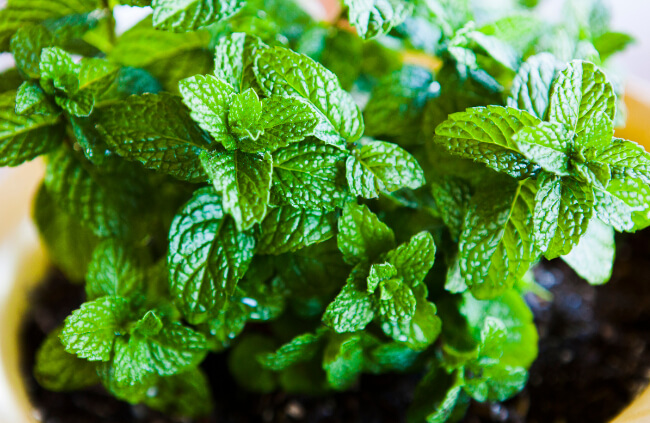
Family: | Lamiaceae |
|---|---|
Genus: | Mentha |
Species: | Various |
Origin: | Global distribution |
Common Names: | Mint |
Location: | indoor or outdoor |
Type: | Perennial herb |
Growth: | Most mints grow in 30 cm mounds |
Sun requirements: | Full sun |
Foliage Colour: | Green |
Flower Colour: | Pale pink, sometimes very pale blue |
Flowering: | Winter to Spring |
Edible Parts: | all parts of the plant are edible |
Maintenance level: | Low |
Poisonous for pets: | Non-toxic to cats and dogs |
What is Mint?
Mentha, commonly known as mint, is one of the most basic flavours that nearly every human being and animal on the planet is familiar with. It is the base tribe in the Lamiaceae family, containing most other aromatic herbs, and one of the widest spread plants on this earth.
Mint’s roots spread easily in most soil types, pushing through loose soil when possible, and growing out overground as stolons (surface root runners) when necessary. Some mints are low growing, ground covering, even weeping, and others grow up to 1.5 m tall.
Depending on their distribution and habitat, there are mints which are covered in fine fur to conserve moisture in hot climates, and others with thin papery foliage to prevent evaporation in shaded conditions.
Some mints grow in water, both still and moving, and others will grow happily in free-draining grit. It’s these wide-ranging differences within this genus that make it such a successful plant, but it is its intensity of rich essential oils that provide the flavour we cultivate it for today.
Best Types of Mint to Grow in Australia
For the sake of keeping this short, I’ll not go into too much detail, but there are about thirty recognised species of mint across the globe, and at least as many hybrids, with various cultivars of each.
For damp, clay gardens, marsh mint will thrive, while in water gardens, or small spaces where aroma and the sound of water would improve the atmosphere, a small container pond with river mint is an ideal solution.
When it comes to flavours, there is nothing as truly deliciously and sweetly scented as spearmint, but Chocolate mints make for a rich black tea. The countless varieties of mint there are, not only taste different, but grow differently too.
Some have plumper foliage which works well in tea, but is awful when cooked with, and others have such delicate foliage that it literally melts in the mouth.
How to Grow Mint in Australia
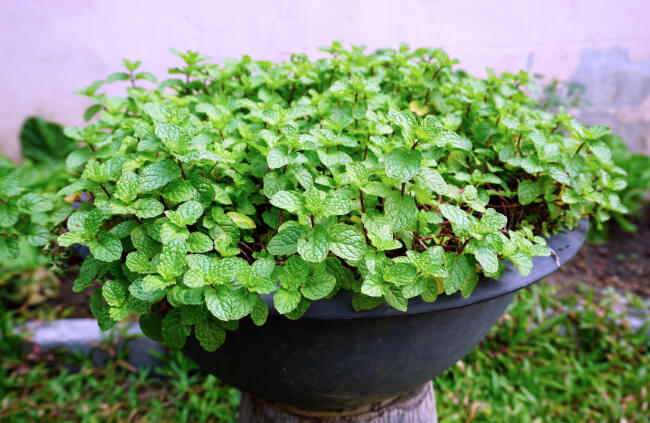
Mint is (almost) impossible to get wrong. Most varieties grow in roughly the same conditions, with a few that require submersion, or boggy conditions, and others that will only be able to exist in pure, free-draining, grit.
Or the rest, mint just needs a pot filled with poor soil, and a reasonable amount of water once a week through summer while it’s in full swing. Because of its tendency to spread, it’s best to grow mint in pots, or create root barriers to limit its spread in the ground.
Growing Mint in Pots and Containers
The easiest way to grow mint is in a container. Make sure it drains well by adding crocks and, where possible, plant into a thick walled, frost-proof stone or ceramic pot. Provided you’ve got crocks, or some sort of non-degradable drainage layer at the base of your container, you can use any compost, but something with a little bit of drainage is ideal.


Get Your Free Guide:
Master Growing Australian Natives eBook
A Must Have Complete Guide for Every Australian Garden
Get Your Free Guide:
Master Growing Australian Natives eBook
A Must Have Complete Guide for Every Australian Garden
I also grow citrus trees here, so nearly always use the sandy compost mix from my citrus trees to plant mint into, but it will grow equally well in spent compost from the veggies patch. Spearmint in particular seems to adore growing in used tomato compost. Even last year’s blight tends not to affect the mint, and it makes use of an otherwise useless growing medium.
Tip: One word of caution… even if you grow mint in pots, its stolons can creep into other pots if they are positioned in groups, and mint transfers flavour from one plant to the next, so keep different varieties separate.
Finding the Best Position for Mint Plants in Australia
Mint wants full sun. The heat brings out the essential oils, triggers flowering (which are also edible), and not only improves its growth but makes it an incredibly effective pest deterrent.
Mammals like us might adore mint (my rabbits can never get enough of the stuff) but insects hate it. Bees and pollinators tend to the flowers well, and benefit from them, but mosquitoes, aphids, and most pest species really, really hate it.
For me, that means a bright, sunny patio, in pots around the seating area is the perfect spot for any mint.
How to Grow Mint in the Ground
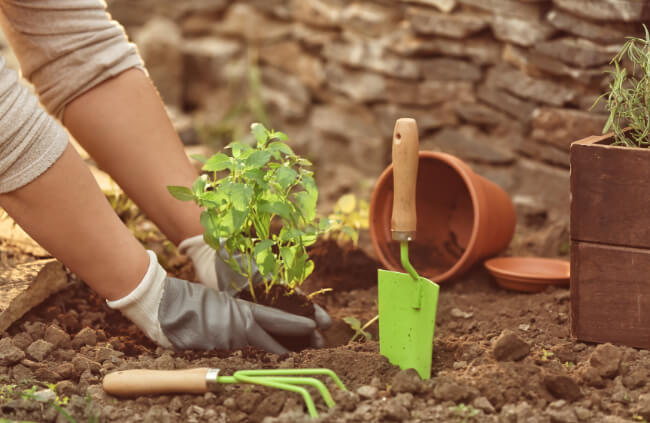
Ok. So don’t say I didn’t warn you. Mint will spread, and it will do it well. Not just mint either. Catmint (Nepeta), most Salvias, bee balm… the entire plant family spreads, by seed, by root, by stolon.
However… I’d be a hypocrite if I didn’t tell you that I do grow mint in my borders, and while it does spread, it is manageable. Just about.
How to Stop Mint from Spreading
If you provide the same conditions as potted mint, with good drainage, reasonably poor soil, and full sun, mint will thrive in the ground. To limit its spread to stolons and seed, plunge your mint in plastic pots, rather than planting it directly.
Or, plant your mint as a base for annuals and self-seekers. That way, once a year in winter, you’ll have an empty bed, which will make it easy to simply dig up any excess mint and compost it.
The problem with plunge planting is that it can cause moisture retention in the plastic container, so cut the base out, or rather than plunging, bury Perspex or copper sheets as square dividers around each plant.
That way, you can plant your mint in a square of open ground, and it can spread quite happily to provide a generous flowering, scented mount. Once a year just pull up any rooted sections around the containing edging.
Growing Mint Indoors

Growing mint indoors is super simple, but remember, you’re growing plants that naturally want to be about 30 cm-1 m tall, and equally wide, so they will need regular pruning, whether you’re using them or not.
Containers for Mint Indoors
Any decorative pot will be fine for indoor mint. You don’t need extra drainage at the base, as it will be positioned in a bright, sunny window, which will dry the soil between waters.
We tend to use indoor mint as an excuse to add to our collection of unusually flavoured mints, so grow about twenty small (15 cm) pots of mint on one long windowsill in the kitchen making it perfect for a windowsill herb garden.
It means we can keep things like Chocolate mint and Banana mint indoors, ready to use fresh in teas, while our larger, more industrial mints like spearmint can grow on the full size outside.
Where to Grow Mint Indoors
Grow your mint on a bright windowsill in full sun. In summer, make sure they are ventilated and get some sort of natural air flow by opening the window regularly.
In winter, try to keep the mint reasonably dry, watering just lightly if the soil dries out. Damp, cool soil in winter is one of the few things that will kill mint.
How Often to Cut and Harvest Mint Indoors
Because most mint species want to spread out, it’s important to regularly harvest your indoor mints. The more regularly you cut them, the bushier they will become. A single mint plant in a 15 cm pot can become an incredibly tight little ball of mint.
Prune them all with clean scissors once a fortnight as a minimum. That way, whenever you harvest it, you’ll get fresh, young, tender leaves, rather than more mature foliage.
How to Propagate Mint
Mint barely needs propagation by humans. If you put it in your garden it will almost certainly propagate itself, either by division, stolons or seed. However, if you’re looking to intentionally expand your mint collection, there are a few ways to do it, and have fun along the way.

Propagating Mint from Seeds
Sowing mint is probably the slowest way to get new mint plants, but it’s the most cost effective, especially if you’re starting from scratch. Sow mint directly onto the surface of a well-drained seed compost, watering it in to provide contact with the soil, and leave it for a few weeks.
If planted in late spring or early autumn mint seeds should germinate reliably in around three weeks. Keep the soil moist but not wet, and prick seedlings out when they have a full spray of true leaves.
Plant the young seedlings into small individual pots of free-draining compost, or loose garden soil mixed with perlite or grit.
Mint Propagation from Cuttings
Mint cuttings take so quickly that it happens by accident most of the time. Whenever we harvest mint, we pop it in a glass of water on the windowsill to stay fresh until we need it.
Sometimes mint can start to root in as little as 48 hours. Once those roots reach about 3 cm long, gently shake off excess water and plant them into small pots filled with a 50:50 mix of compost and grit.
Keep them moist and in bright but indirect light for a week, until they’ve got a decent root system in their small pots, then plant them into a final position.
Propagating Mint from Division
And finally, the easiest way of all to create new mint plants? Divide them. Mint will create new plants around its base all the time, to the point that most mint plants that have been in your garden are usually made up of about thirty or forty plants, rather than just one.
All you need to do is dig a spade through the middle of a clump of mint, and plant whatever you dig up into a new pot. For young plants that are just rooted, you can prick them out of the soil with a small pencil or even a kitchen fork.
Plant them carefully into small pots. When their roots poke out of the base you’ve got a new mint plant, ready to plant out.
How to Care for Mint
Ongoing care for mint is pretty straightforward. Just don’t overwater it, and definitely don’t mulch it. Mint is not a hungry plant, and does not need feeding. Water, and the basic nutrients in your garden soil will be enough to keep it going.
Even in containers, the spent compost you plant mint with initially will last right through until it needs repotting, so there’s no need to mulch, feed, or even water mint on a regular basis.
Pruning Mint
One thing that really is essential for a healthy, neat-looking mint, is pruning. That pruning isn’t rocket science, and if you like cooking with it, it’s barely even a chore. Cut mint back on each stem by at least three nodes every time you harvest it.
If it’s leggy, you can cut it back hard, and it will quickly reform into a neat, bushy plant. As it bushes out, those three nodes get shorter each time, and the mint you harvest gets better.
Caring for Mint through Winter
As winter approaches, mint will slow down, regardless of where you are in the country. Cut your mint back hard on one side in mid autumn. This encourages a new flush of growth, ready to harvest and dry for winter, but leaves you with enough to harvest for the next few weeks.
Harvesting and Storing Mint
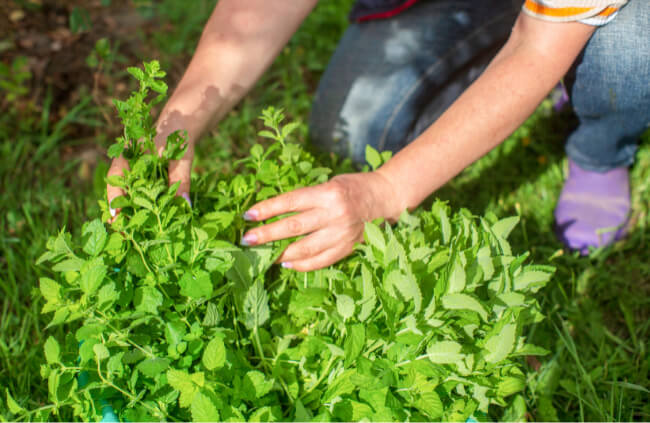
Every time you harvest mint, cut it back to just above a set of leaves. This encourages new growth from the small shoots you’ll notice just above those leaves. Mint can be used straight away, but stores well, and retains its flavour for months.
To prepare mint for storage, hang it upside down, with space between each stem for about a week. Once the leaves are crunchy and the stem snaps crisply when bent, it’s ready to break up and store in air-tight containers (zip lock bags are ideal and space saving).
Possible Mint Pests and Diseases
Flea beetles and spider mites are quite common mint pests, due to their preference for slightly drier soils. Caterpillars and aphids can infest mint if there isn’t much else in the garden, but will usually steer clear.
Mint is generally good at deterring most pests without any help from us gardeners, but if you notice anything causing regular damage, just pick it off or blast it with a host. To deter spider mites, wet the soil at the base of the mint thoroughly, and leave it to dry out.
That should drive them away for a while. (Should you need more help, check out our in-depth guide on dealing with spider mites.)
Puccinia rust, powdery mildew and verticillium wilt all affect mint, and all have similar symptoms. Leaves will take on a faint powdery coating (rust and verticillium are orangey or yellow, while mildew is grey).
They can all be treated by removing the affected area and cutting the plant back hard. Try to keep foliage dry to prevent these sorts of fungal leaf infections.
Mint Frequently Asked Questions

What’s the secret to growing mint?
There’s no secret to growing mint. If you’ve ever had problems growing it, chances are it’s in a pot that’s too small, or its soil holds too much moisture. Mint likes good drainage, full sun, and plenty of root space.
Why should you not grow mint?
One of the biggest reasons people choose not to grow mint is its invasive habit. It will almost definitely try to take over your garden, whether it’s in pots, containers, hanging baskets or in the ground. However, it’s easy to weed out and can be controlled, especially in pots.
Do you pick mint leaves from the top or bottom?
Mint should always be picked from the top, not the bottom of the plant. While the lower leaves might look tempting due to their larger size, the smaller leaves have better flavour and a better texture. Picking from the top also encourages new growth.
What should you not plant near mint?
Any other aromatic herbs should be avoided in close proximity to mint. The flavours will blend, and rub off between foliage, clouding the flavours of each herb. The same goes when planting different types of mint together – keep them separate.
What hates mint?
Cabbage white butterflies, moths, ants, rats, fleas, and aphids hate mint. It’s a great way to keep them away from your house, and out of your garden. If you plant it in pots near tomatoes, cabbages, cucumbers, or potatoes it can protect them from many common pests.
Wrapping Up Our Mint Growing Guide
Mint is, and always will be, a popular garden plant, but there are some gardeners who are understandably afraid of growing it in their own plot.
All I can say is with an open mind, and a little bit of effort, it is a controllable plant; its scent is to die for; and if you’ve got even the slightest inclination to grow mint, then give it a go.
Published on August 4, 2023 by Maisie Blevins
Last Updated on September 20, 2024


